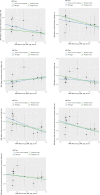Association of Lipoprotein (a) variants with risk of cardiovascular disease: a Mendelian randomization study
- PMID: 34074296
- PMCID: PMC8170931
- DOI: 10.1186/s12944-021-01482-0
Association of Lipoprotein (a) variants with risk of cardiovascular disease: a Mendelian randomization study
Abstract
Background: There is a well-documented empirical relationship between lipoprotein (a) [Lp(a)] and cardiovascular disease (CVD); however, causal evidence, especially from the Chinese population, is lacking. Therefore, this study aims to estimate the causal association between variants in genes affecting Lp(a) concentrations and CVD in people of Han Chinese ethnicity.
Methods: Two-sample Mendelian randomization analysis was used to assess the causal effect of Lp(a) concentrations on the risk of CVD. Summary statistics for Lp(a) variants were obtained from 1256 individuals in the Cohort Study on Chronic Disease of Communities Natural Population in Beijing, Tianjin and Hebei. Data on associations between single-nucleotide polymorphisms (SNPs) and CVD were obtained from recently published genome-wide association studies.
Results: Thirteen SNPs associated with Lp(a) levels in the Han Chinese population were used as instrumental variables. Genetically elevated Lp(a) was inversely associated with the risk of atrial fibrillation [odds ratio (OR), 0.94; 95% confidence interval (95%CI), 0.901-0.987; P = 0.012)], the risk of arrhythmia (OR, 0.96; 95%CI, 0.941-0.990; P = 0.005), the left ventricular mass index (OR, 0.97; 95%CI, 0.949-1.000; P = 0.048), and the left ventricular internal dimension in diastole (OR, 0.97; 95%CI, 0.950-0.997; P = 0.028) according to the inverse-variance weighted method. No significant association was observed for congestive heart failure (OR, 0.99; 95% CI, 0.950-1.038; P = 0.766), ischemic stroke (OR, 1.01; 95%CI, 0.981-1.046; P = 0.422), and left ventricular internal dimension in systole (OR, 0.98; 95%CI, 0.960-1.009; P = 0.214).
Conclusions: This study provided evidence that genetically elevated Lp(a) was inversely associated with atrial fibrillation, arrhythmia, the left ventricular mass index and the left ventricular internal dimension in diastole, but not with congestive heart failure, ischemic stroke, and the left ventricular internal dimension in systole in the Han Chinese population. Further research is needed to identify the mechanism underlying these results and determine whether genetically elevated Lp(a) increases the risk of coronary heart disease or other CVD subtypes.
Keywords: Arrhythmia; Atrial fibrillation; Cardiovascular risk; Congestive heart failure; East Asian; Ischemic stroke; Lipoprotein (a).
Conflict of interest statement
All authors declare that they have no competing interests.
Figures



References
-
- National Center for Cardiovascular Diseases, China . Annual report on cardiovascular health and diseases in China. Beijing: Science Press; 2020. pp. 142–222.
-
- World Health Organization. https://www.who.int/news/item/09-12-2020-who-reveals-leading-causes-of-d... (accessed January 19, 2021).
-
- The Writing Committee of the Report on Cardiovascular Health and Diseases in China. Interpretation of Report on Cardiovascular Health and Diseases in China Chin. J Cardiovasc Med, 2020. 2019;25(05):401–410.
-
- Ooi EM, Ellis KL, Barrett PHR, Watts GF, Hung J, Beilby JP, et al. Lipoprotein(a) and apolipoprotein(a) isoform size: associations with angiographic extent and severity of coronary artery disease, and carotid artery plaque. Atherosclerosis. 2018;275:232–238. doi: 10.1016/j.atherosclerosis.2018.06.863. - DOI - PubMed
MeSH terms
Substances
Grants and funding
LinkOut - more resources
Full Text Sources
Medical
Miscellaneous

